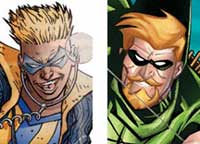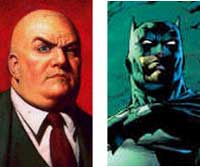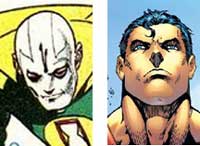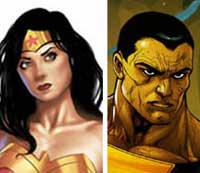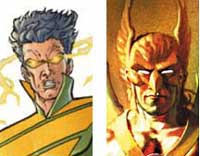Comics /
Cult Favorite
Non-crisis on the Infinite Earths
By Philip Schweier
July 5, 2008 - 16:12
Final Crisis. Emphasis on the "final." Or so we can hope.
In recent years we have been treated to mega-events from DC Comics, such as Our World at War, Identity Crisis, Infinite Crisis and a host of miscellaneous tie-ins, as well two weekly series, 52 and Countdown to Final Crisis, running almost back-to-back.
On top of that there have been epic storylines such as the Sinestro Corps War in Green Lantern and Green Lantern Corps, The Resurrection of Ra's al Ghul in the Batman titles and The Lightning Saga in the Justice League and Justice Society books.
When the issue of battle fatigue has been brought up at various conventions, DC Comics editor-in-chief Dan DiDio acknowledges the possibility, but argues that the publisher is not out to flood its readers with an endless series of event-oriented comics. Its goal, he says enthusiastically, is to tell great stories.
An admirable goal, to be sure, but even the deepest creative well eventually runs dry, and one can't help but wonder at what point do comic book writers such as Geoff Johns, Greg Rucka and Paul Dini begin to feel the effects of telling grand epics. Grant Morrison has said that he is looking forward to exploring the super-hero genre on a smaller, more individual scale when he takes the reins of Batman following Final Crisis.
And let's face it, not every "great story" needs to be a six-issue saga that spans 80 percent of DC's titles. Some of the most memorable stories have been single-issue tales, such as
New Teen Titans #20: "Dear Mom and Dad" by Marv Wolfman, George Perez and Romeo Tanghal or
Superman Annual #11: "For The Man Who Has Everything" by Alan Moore and Dave Gibbons.
As the
Final Crisis nears, many readers hope that things in the DC Universe will settle down, while maintaining the ambitious writing that has been the trend over the past few years. Being free from having to tie so closely to other titles may allow writers greater freedom to craft stories that otherwise might be hamstrung by continuity concerns and the like.
It once was understood that the events that took place in titles such as
Batman and
Detective Comics weren't referred to in
Justice League of America because each adventure took place in between others. But in those days, stories were usually told in a single issue, two at the most. Today, most story arcs run about six issues.
But the fact remains that not every character's story runs into another's. Anyone from a large family will tell you that one sibling's life events do not necessarily have a direct impact on a brother of sister. Once in a while, there is some crossover, because such is the nature of inter-woven relationships. But if Black Canary is injured in battle in the pages of
Justice League of America, does Superman really need to comment on it in
Action Comics?
At Heroes Con in Charlotte, N.C., recently, DiDio all but decreed that
Final Crisis will indeed be final so long as he is in charge. And while "never say never" is often the response to such promises, I'll leave that debate for others to chew on.
My question is how to stir the pot without creating some Earth-shattering disaster or killing off assorted characters. Well, I've got an idea, and if the powers that be at DC Comics care to listen, I'll be happy to share.
Gather 'round, children, as ol' Unca Philby outlines his recipe for a "New DC Universe That Doesn't Involve a Crisis."
Suppose a relatively minor villain, say, the Trickster, gets his clock cleaned one too many times by the Flash, and decides he's had enough hanging around Central City trying stay ahead of the Fastest Man Alive. Perhaps it's time to move somewhere where there are no super-powered beings looking to cramp his style – like Star City. Why not? What's Green Arrow got going? A bunch of trick arrows shouldn't be a problem for someone named the Trickster.
Meanwhile...
In Metropolis, Lex Luthor decides that all the resources of LexCorp haven't made so much as a dent in the Man of Steel. Since there is strength in numbers, Luthor decides it's time to gather as many resources as he can, beginning with Kord Industries, which has been in a slump since the death of Ted Kord aka the Blue Beetle. Easy pickings, though Wayne Enterprises makes a last minute bid for the company. With Bruce Wayne and Lex Luthor's companies now in an adversarial relationship, it shouldn't be long before Lex makes a takeover bid for Wayne Enterprises, drawing the attention of Batman.
Meanwhile...
Chronos is mucking about with time, as usual, and manages to open up a temporal can of worms the likes of which is beyond his control. Looks like a job for Superman, no?
Meanwhile...
Black Adam has begun to lock horns with Wonder Woman, as eons-old conflicts rooted in ancient Egypt and Greece take on a modern spin.
Meanwhile...
Hawkman battles the eco-terrorist Weather Wizard for supremacy of the skies.
Meanwhile...
Well, you get the idea. It becomes a game of musical villains, with various heroes finding themselves up against opponents we readers know and are familiar with, but whom the heroes may have never battled one-on-one before. It makes sense to me from a character standpoint; if one rival knows all your moves, take on someone who doesn't.
There's also merit from a publishing point of view, as it avoids the necessity of creating new villains for old heroes, or re-inventing old villains. There's a familiarity, but a fresh new approach. Maybe some of the match-ups might raise a few eyebrows, but I'm sure mustard and honey was a combination that few thought would ever take off.
Maybe such a plan is already in the works. Or maybe the powers that be have a completely different idea, and already planning the next big event. If you as a reader are experiencing "crisis fatigue," just remember there is no one holding a gun to your head. Whether you as a reader approve or not, the best way for your voice to be heard is in what you buy.
Praise and adulation? Scorn and ridicule? E-mail me at philip@comicbookbin.com
Last Updated: March 3, 2025 - 20:40

